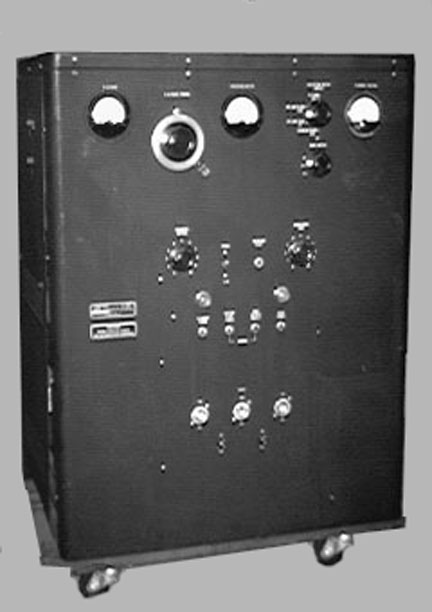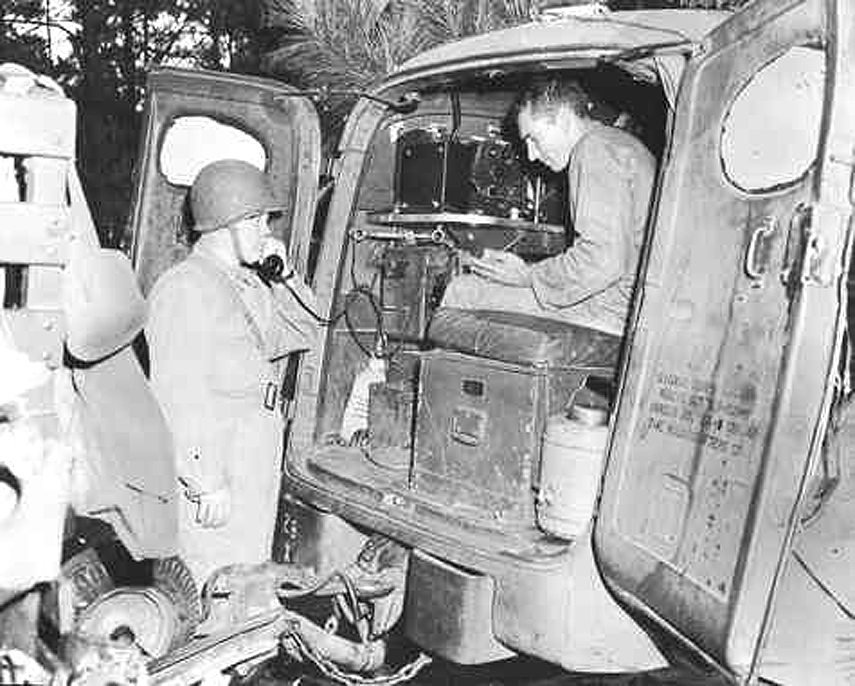|
BC-610
The BC-610 was a radio transmitter based on the Hallicrafters HT-4 and was used by the U.S. Army Signal Corps during World War II. History In the early 1940s, the U.S. military sought a high-powered radio transmitter capable of infallible voice communications over 100 miles (160 km), sturdy enough to work in all conditions, flexible enough to be able to cover a wide range of frequencies, self-powered and able to operate in motion or at fixed locations. The Hallicrafters HT-4 transmitter was chosen from units available from various U.S. radio manufacturers. The HT-4 was designed for amateur radio use and had been commercially available for several years at a price of approximately $700, rivaling the cost of a car. It was considered compact and stable for its era and could deliver in excess of 300 watts of power for voice or MCW communications and 400 watts during Morse code operation. As was typical in physically large vacuum tube equipment, the manual cautions power output ... [...More Info...] [...Related Items...] OR: [Wikipedia] [Google] [Baidu] |
SCR-299
The SCR-299 was a U.S. Signal Corps mobile military communications unit used during World War II. History The SCR-299 "mobile communications unit" was developed to provide long-range communications during World War II. The US Military sought improvements of range, flexibility and durability over its existing SCR-197 and SCR-597 transmitters. In 1942, Hallicrafters Standard HT-4 was selected as the SCR-299's transmitter, known subsequently by its military designation as the BC-610. The SCR-299 was first used on November 8, 1942 during Operation TORCH involving companies of the 829th Signal Service Battalion establishing a radio net that could exchange messages between beach-landed forces and bases in Gibraltar. Despite initial problems unloading the sets from convoy ships, the SCR-299s served until the installation of permanent Army Command and Administrative Network stations. According to US Army military historians, "General Dwight Eisenhower credited the SCR-299 in his successful ... [...More Info...] [...Related Items...] OR: [Wikipedia] [Google] [Baidu] |
Hallicrafters
The Hallicrafters Company manufactured, marketed, and sold radio equipment, and to a lesser extent televisions and phonographs, beginning in 1932. The company was founded by William J. Halligan and based in Chicago, Illinois, United States. In 1966 Halligan sold the company to the Northrop Corporation and Halligan family involvement ended. Northrop ran the company until the early 1970s, but by this time, fierce Japanese competition was putting pressure on the US domestic electronics market. Northrop sold the company name (but kept the factory, by then located in Rolling Meadows, a Chicago suburb) in 1975, bringing non-military electronics production to an end, and turning the plant into Northrop Corporation's Defense Systems Division. History William J. Halligan (1898–1992), founded Hallicrafters Company in Chicago in late 1932. Prior to this, he had been involved in radio parts sales for some years but decided the time was right for a handcrafted amateur radio receiver - t ... [...More Info...] [...Related Items...] OR: [Wikipedia] [Google] [Baidu] |
BC-654
The SCR-284 was a World War II era combination transmitter and receiver used in vehicles or fixed ground stations. History The Crosley Corporation of Cincinnati, Ohio manufactured the Signal Corps Radio set SCR-284 that consisted of the BC-654 and associated support equipment. The SCR-284 was introduced in Africa during Operation Torch and was the first radio set used for communications from the beach to the U.S. Fleet to coordinate naval gunfire and beach radio networks.The American GI in Europe in World War II: The March to D-Day'. Stackpole Books; 22 September 2009. . p. 51–. The set was used by Merrill's Marauders while operating in the China-Burma-India Theater and missions behind Japanese lines in Burma to communicate with air transport and other military aircraft, although some radiomen complained that it was "very inefficient" compared to other radio sets and "very hard to generate power".Gavin Mortimer. Merrill's Marauders: The Untold Story of Unit Galahad and the ... [...More Info...] [...Related Items...] OR: [Wikipedia] [Google] [Baidu] |
BC-348
The BC-348 is a compact American-made communications receiver, which was mass-produced during World War II for the U.S. Army Air Force. Under the joint Army-Navy nomenclature system, the receiver system became known as the AN/ARR-11. History The BC-348 is the 28 vdc powered version of the 14 vdc powered BC-224. The first version, the BC-224-A, was produced in 1936. Installed in almost all USAAF (and some USN, some British and some Canadian) multi-engined transports and bombers used during the fifteen-year period from before World War II through the Korean War, BC-348 radio receivers were easy to operate and reliable. Designed as LF/MF/HF receivers for use in larger aircraft (B-17, B-24, B-25, B-26, B-29, C-47, etc.), they were initially paired with a BC-375 transmitter in the ''SCR-287-A'' system. Late in World War II, the AN/ARR-11 (BC-348) was the receiver and the AN/ART-13A ( ART-13) was the transmitter in the AN/ARC-8 system. They were also used in some ground and mobile i ... [...More Info...] [...Related Items...] OR: [Wikipedia] [Google] [Baidu] |
Operation Fortitude
Operation Fortitude was the code name for a World War II military deception employed by the Allied nations as part of an overall deception strategy (code named ''Operation Bodyguard, Bodyguard'') during the build-up to the 1944 Normandy landings. Fortitude was divided into two sub-plans, North and South, with the aim of misleading the German High Command as to the location of the invasion. Fortitude had evolved from plans submitted by Noel Wild, head of Ops (B), and John Bevan, from the London Controlling Section in late 1943. Early revisions in January 1944 suggested a fictional build up of troops in southern England with the hope of drawing German attention to the Calais region. Colonel David Strangeways, head of Montgomery's R Force deception staff, was unimpressed with the approach. Strangeways was widely critical of the original plan and eventually re-wrote the Fortitude deception with a focus on creating a more realistic threat. Both Fortitude plans involved the creatio ... [...More Info...] [...Related Items...] OR: [Wikipedia] [Google] [Baidu] |
Pound (mass)
The pound or pound-mass is a unit of mass used in British imperial and United States customary systems of measurement. Various definitions have been used; the most common today is the international avoirdupois pound, which is legally defined as exactly , and which is divided into 16 avoirdupois ounces. The international standard symbol for the avoirdupois pound is lb; an alternative symbol is lbm (for most pound definitions), # ( chiefly in the U.S.), and or ″̶ (specifically for the apothecaries' pound). The unit is descended from the Roman (hence the abbreviation "lb"). The English word ''pound'' is cognate with, among others, German , Dutch , and Swedish . These units are historic and are no longer used (replaced by the metric system). Usage of the unqualified term ''pound'' reflects the historical conflation of mass and weight. This accounts for the modern distinguishing terms ''pound-mass'' and ''pound-force''. Etymology The word 'pound' and its cognate ... [...More Info...] [...Related Items...] OR: [Wikipedia] [Google] [Baidu] |
Signal Corps Radio
Signal Corps Radios were U.S. Army military communications components that comprised "sets". Under the Army Nomenclature System, the abbreviation SCR initially designated "Set, Complete Radio", but was later misinterpreted as "Signal Corps Radio." Nomenclature The term SCR was part of a nomenclature system developed for the U.S. Signal Corps, used at least as far back as World War I. Three-letter designators beginning with "SC" were used to denote complete systems, while one and two-letter designators (such as "BC", for basic component, "FT" for mounting, etc.) were used for components. Only a few system designators were used: :::SCM Set, Complete, Meteorological :::SCR Set, Complete, Radio :::SCS Set, Complete, System SCR radio sets The U.S. Signal Corps used the term "sets" to denote specific groupings of individual components such as transmitters, receivers, power supplies, handsets, cases, and antennas. SCR radio sets ranged from the relatively small SCR-536 "handie ... [...More Info...] [...Related Items...] OR: [Wikipedia] [Google] [Baidu] |
Eimac
Eimac is a trade mark of Eimac Products, part of the Microwave Power Products Division of Communications & Power Industries. It produces power vacuum tubes for radio frequency applications such as broadcast and radar transmitters. The company name is an initialism from the names of the founders, William Eitel and Jack McCullough. History The San Francisco Bay area was one of the early centers of amateur radio activity and experimentation, containing about 10% of the total operators in the US. Amateur radio enthusiasts sought vacuum tubes that would perform at higher power and on higher frequencies than those then available from RCA, Western Electric, General Electric, and Westinghouse. Additionally, they required tubes that would operate with the limited voltages available from typical amateur power supplies. While employed by the small San Francisco, California manufacturing firm of Heintz & Kaufman which manufactured custom radio equipment, Bill Eitel (amateur radio call sign W6U ... [...More Info...] [...Related Items...] OR: [Wikipedia] [Google] [Baidu] |
Vacuum Tube
A vacuum tube, electron tube, valve (British usage), or tube (North America), is a device that controls electric current flow in a high vacuum between electrodes to which an electric voltage, potential difference has been applied. The type known as a thermionic tube or thermionic valve utilizes thermionic emission of electrons from a hot cathode for fundamental electronic functions such as signal amplifier, amplification and current rectifier, rectification. Non-thermionic types such as a vacuum phototube, however, achieve electron emission through the photoelectric effect, and are used for such purposes as the detection of light intensities. In both types, the electrons are accelerated from the cathode to the anode by the electric field in the tube. The simplest vacuum tube, the diode (i.e. Fleming valve), invented in 1904 by John Ambrose Fleming, contains only a heated electron-emitting cathode and an anode. Electrons can only flow in one direction through the device—fro ... [...More Info...] [...Related Items...] OR: [Wikipedia] [Google] [Baidu] |
Radio Frequency
Radio frequency (RF) is the oscillation rate of an alternating electric current or voltage or of a magnetic, electric or electromagnetic field or mechanical system in the frequency range from around to around . This is roughly between the upper limit of audio frequencies and the lower limit of infrared frequencies; these are the frequencies at which energy from an oscillating current can radiate off a conductor into space as radio waves. Different sources specify different upper and lower bounds for the frequency range. Electric current Electric currents that oscillate at radio frequencies (RF currents) have special properties not shared by direct current or lower audio frequency alternating current, such as the 50 or 60 Hz current used in electrical power distribution. * Energy from RF currents in conductors can radiate into space as electromagnetic waves ( radio waves). This is the basis of radio technology. * RF current does not penetrate deeply into electrica ... [...More Info...] [...Related Items...] OR: [Wikipedia] [Google] [Baidu] |
Continuous Wave
A continuous wave or continuous waveform (CW) is an electromagnetic wave of constant amplitude and frequency, typically a sine wave, that for mathematical analysis is considered to be of infinite duration. It may refer to e.g. a laser or particle accelerator having a continuous output, as opposed to a pulsed output. Continuous wave is also the name given to an early method of radio transmission, in which a sinusoidal carrier wave is switched on and off. Information is carried in the varying duration of the on and off periods of the signal, for example by Morse code in early radio. In early wireless telegraphy radio transmission, CW waves were also known as "undamped waves", to distinguish this method from damped wave signals produced by earlier '' spark gap'' type transmitters. Radio Transmissions before CW Very early radio transmitters used a spark gap to produce radio-frequency oscillations in the transmitting antenna. The signals produced by these spark-gap tr ... [...More Info...] [...Related Items...] OR: [Wikipedia] [Google] [Baidu] |







